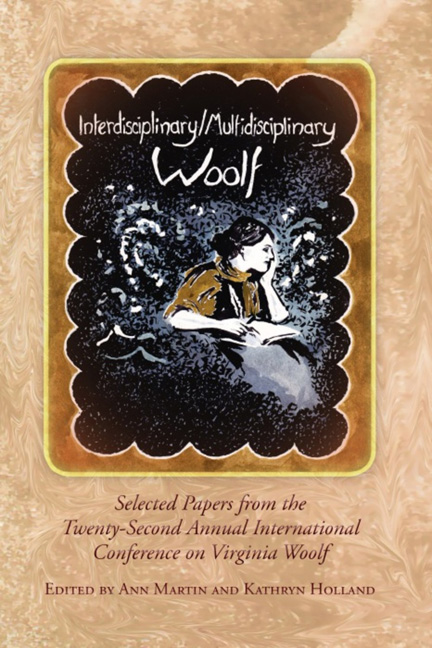Book contents
- Frontmatter
- Contents
- Introduction to Interdisciplinary/Multidisciplinary Woolf
- Acknowledgments
- List of Abbreviations
- History, Materiality, Multiplicity
- Multidisciplinary Woolf / Multiple Woolfs?
- Woolf, History, Us
- “Full of Experiments and Reforms”: Virginia Woolf, John Maynard Keynes, and the Impossibility of Economic Modeling
- Desiring Statues and Ambiguous Sexualities in Jacob's Room
- Challenging the Family Script: Woolf, the Stephen Family, and Victorian Evangelical Theology
- History as Scaffolding: Woolf's Use of The Times in The Years
- Vincent van Gogh, Virginia Woolf, and Old Shoes: A Cross-Cultural Iconography of Historical Truama from the Great War to the Iraq War
- Stopped at the Border: Virginia Woolf and the Criminalization of Dissent in Democratic Societies
- “Q. And babies? A. And babies”: On Pacifism, Visual Truama, and the Body Heap
- Photography, History, and Memoir of the Spanish Civil War: Interdisciplinary Views
- Patterns, Practices, Principles
- Art, Influence, Embodiment
- Publishing, Politics, Publics
- Notes on Contributors
- Conference Program
History as Scaffolding: Woolf's Use of The Times in The Years
from History, Materiality, Multiplicity
- Frontmatter
- Contents
- Introduction to Interdisciplinary/Multidisciplinary Woolf
- Acknowledgments
- List of Abbreviations
- History, Materiality, Multiplicity
- Multidisciplinary Woolf / Multiple Woolfs?
- Woolf, History, Us
- “Full of Experiments and Reforms”: Virginia Woolf, John Maynard Keynes, and the Impossibility of Economic Modeling
- Desiring Statues and Ambiguous Sexualities in Jacob's Room
- Challenging the Family Script: Woolf, the Stephen Family, and Victorian Evangelical Theology
- History as Scaffolding: Woolf's Use of The Times in The Years
- Vincent van Gogh, Virginia Woolf, and Old Shoes: A Cross-Cultural Iconography of Historical Truama from the Great War to the Iraq War
- Stopped at the Border: Virginia Woolf and the Criminalization of Dissent in Democratic Societies
- “Q. And babies? A. And babies”: On Pacifism, Visual Truama, and the Body Heap
- Photography, History, and Memoir of the Spanish Civil War: Interdisciplinary Views
- Patterns, Practices, Principles
- Art, Influence, Embodiment
- Publishing, Politics, Publics
- Notes on Contributors
- Conference Program
Summary
The 1977 winter issue of the Bulletin of the New York Public Library on The Years launched a continuing debate about Woolf's process of revision and her expunging of factual detail in the final published version. Most significant for future scholarship were Grace Radin's transcription of two large expurgated chunks—the first, as Radin initially and erroneously believed, part of the published 1917 wartime section, and the second an omitted 1921 section. What Radin missed in 1977 and later in her 1981 book-length study of The Years, Karen Levenback discovered in her work on Woolf and war in 1994: the wartime expurgated portion of The Years takes place on September 22, 1914 when late edition newspaper headlines proclaimed the sinking of three British cruisers by a German submarine in the North Sea (Levenback 8).
This re-dating of an earlier section of the novel based on evidence from London newspapers, possibly The Evening Standard which ran a headline on September 22, 1914: “British Naval Disaster” with the subheading “Three Cruisers Sunk in the North Sea,” suggests a relatively neglected approach to Woolf's late fiction. While we know that Woolf collected newspaper clippings in preparation for writing Three Guineas, none of those clippings makes its way explicitly into The Years. Instead, we can now accurately date several of the days within the sections labeled only by year from seemingly random references to newspaper articles the characters are reading. From the Malones’ Oxford sitting room in 1880 to the newspaper placards announcing the death of Thomas Parnell in 1891 to the death of King Edward in 1910 and the sinking of the British cruisers in 1914, we observe how Woolf carefully anchors her narrative to historical events until The Present Day where she purposely blurs references but allows past events to undergird our perception of the characters.
Here I deal largely with the scenes and implications of newspaper reading in both the published novel and the omitted 1914 section, withdrawn during Woolf's late revisions at the galley proof stage in the autumn of 1936.
- Type
- Chapter
- Information
- Interdisciplinary/Multidisciplinary Woolf , pp. 41 - 49Publisher: Liverpool University PressPrint publication year: 2013



